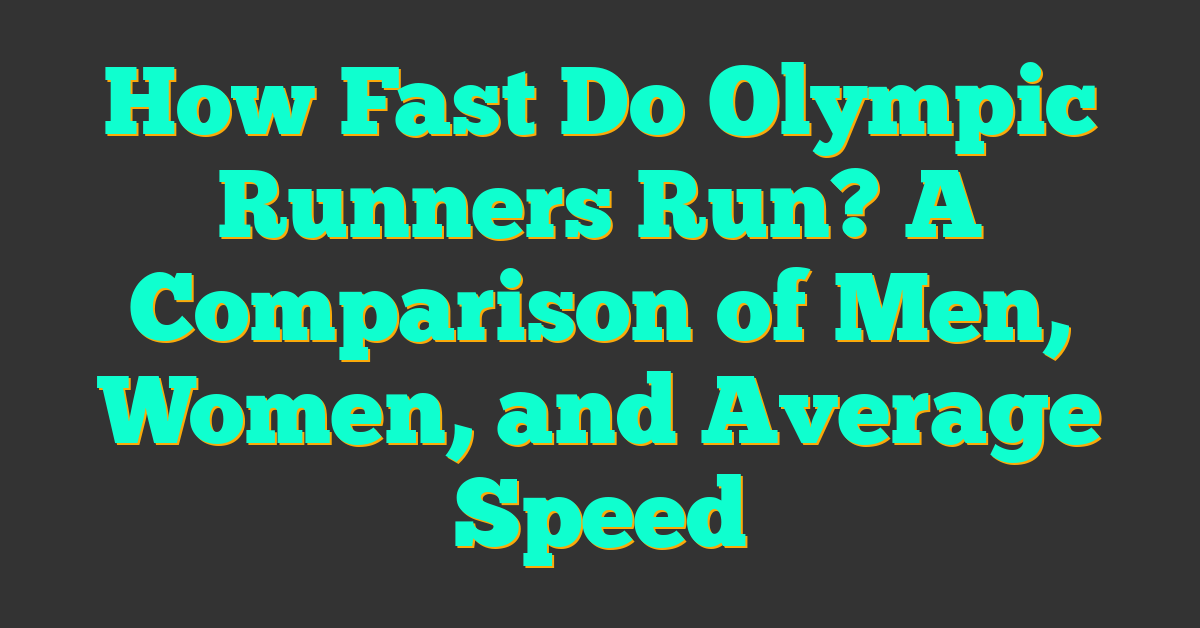If you’ve ever watched the Olympics, you’ve probably marveled at the incredible speed and endurance of the runners. But just how fast do Olympic runners run, and how do men’s and women’s performances compare? In this article, we’ll explore the world of Olympic running and shed some light on these questions.


Understanding Running Speed
Running speed is typically measured in meters per second, or in minutes per mile or kilometer. Elite runners, however, often use a different metric: minutes per mile or kilometer. This is because they’re typically running at such a fast pace that seconds per meter become less meaningful.
Comparing Elite Male and Female Runners
When it comes to Olympic running, men and women compete separately. This means that we can compare the fastest male and female runners in each event to see how their performances stack up. While men’s and women’s records are generally separate, there are some events where women’s records are close to or even faster than men’s records. For example, the women’s 100-meter and 200-meter records are only slightly slower than the men’s records.
Understanding Running Speed
https://www.youtube.com/watch?v=6XqpY6aah2Y&embed=true
If you’re interested in running, you may have wondered how fast Olympic runners can run. Running speed is influenced by many factors, including genetics, training, and biomechanics. In this section, we’ll explore some of the key factors that influence running speed and how it is measured in athletics.
Key Factors Influencing Speed
Stride Length and Frequency
Stride length and stride frequency are two of the primary factors influencing running speed. Stride length is the distance covered by one step, while stride frequency is the number of steps taken per minute. Elite runners tend to have longer strides and faster stride frequencies than recreational runners. However, it’s important to note that there is no one “correct” stride length or frequency, as these factors can vary depending on an individual’s body mechanics.
Muscle Strength and Power
Muscle strength and power are also important factors influencing running speed. Strong leg muscles can generate more force and power, allowing runners to move faster. Additionally, strong core muscles can help runners maintain good posture and balance, which can improve their running mechanics.
Energy Systems
The body uses three primary energy systems during exercise: the phosphagen system, the glycolytic system, and the oxidative system. The phosphagen system provides energy for short bursts of high-intensity exercise, such as sprinting. The glycolytic system provides energy for moderate-intensity exercise, such as middle-distance running. The oxidative system provides energy for low-intensity exercise, such as long-distance running. Elite runners have highly efficient energy systems, allowing them to sustain high speeds for longer periods of time.
Speed Measurement in Athletics
In athletics, running speed is typically measured using a variety of methods, including:
- Electronic timing systems: These systems use sensors to detect when a runner crosses the finish line, providing accurate and reliable timing data.
- Video analysis: Coaches and trainers may use video analysis to evaluate a runner’s technique and identify areas for improvement.
- GPS tracking: GPS tracking devices can provide data on a runner’s speed, distance, and route.
Overall, running speed is influenced by a variety of factors, and measuring it accurately requires sophisticated technology and analysis. Whether you’re a recreational runner or an elite athlete, understanding the key factors influencing running speed can help you improve your performance and achieve your goals.
Comparing Elite Male and Female Runners
https://www.youtube.com/watch?v=Jua5EiJDinM&embed=true
When it comes to running, the differences between elite male and female runners are clear. Men have consistently faster times than women, with the current world records for men being faster than those for women in every event. However, it’s important to note that both male and female elite runners are incredibly fast and impressive athletes.
World Records and Achievements
Usain Bolt is perhaps the most famous male runner, holding world records in both the 100-meter and 200-meter dash. His fastest time in the 100-meter dash is 9.58 seconds, while the women’s world record is held by Florence Griffith-Joyner at 10.49 seconds. In the 200-meter dash, Bolt’s world record is 19.19 seconds, while the women’s record is held by Florence Griffith-Joyner at 21.34 seconds.
On the other hand, Shelly-Ann Fraser-Pryce is a well-known female runner with impressive achievements. She has won two Olympic gold medals in the 100-meter dash, with her fastest time being 10.63 seconds. She has also won Olympic gold medals in the 2008 and 2012 4×100-meter relay, as well as a silver medal in the 2016 100-meter dash.
Physiological Differences
Physiological differences between men and women contribute to the performance gap between elite male and female runners. Men tend to have larger hearts and lungs, which allows them to take in and use more oxygen during exercise. This leads to a higher VO2 max, which is the maximum amount of oxygen a person can use during exercise. As a result, men tend to have a higher aerobic capacity than women.
In addition, men tend to have more muscle mass and less body fat than women, which can also contribute to their faster running times. However, it’s important to note that there is a wide range of variation within both men and women, and not all men are faster than all women.
Overall, while there are clear differences between elite male and female runners, both groups of athletes are incredibly impressive and skilled.
Average Running Speeds

« How Fast Do Olympic Cyclists Go? Men vs Women vs Triathletes vs Average Cyclist
How Fast Do Olympic Swimmers Swim: Men vs Women vs Average Swimmers? »
If you’re an average runner looking to improve your speed, it’s important to know what determines your average running speed. There are several factors that can impact your pace, including your fitness level, motivation, and overall health.
What Determines an Average Runner
Your fitness level plays a significant role in determining your average running speed. The more you run, the better your endurance and the faster you’ll be able to run. Additionally, your overall health can impact your running speed. If you’re not getting enough sleep, eating a healthy diet, or dealing with an injury, it can affect your performance.
Another factor that can impact your average running speed is motivation. If you’re not motivated to run, it can be challenging to push yourself to run faster. Finding a running partner or group can help keep you motivated and accountable.
Improving Average Running Speeds
If you’re looking to improve your average running speed, there are several things you can do. One of the most effective ways to improve your speed is to incorporate interval training into your workouts. This involves alternating between short bursts of high-intensity running and periods of rest or low-intensity running.
Another way to improve your average running speed is to work on your running form. By focusing on proper form, you can reduce the amount of energy you waste and become a more efficient runner. Additionally, strength training can help improve your running speed by increasing your overall strength and power.
In conclusion, improving your average running speed takes time and effort, but it’s possible with the right training and mindset. By focusing on your fitness level, overall health, motivation, and incorporating interval training, proper form, and strength training into your workouts, you can become a faster and more efficient runner.
Training and Performance Enhancement
https://www.youtube.com/watch?v=a_9maNuGUsY&embed=true
When it comes to Olympic running, training is everything. Effective training techniques can help athletes improve their strength, endurance, and VO2 max, all of which are critical for success on the track.
Effective Training Techniques
Interval training is one of the most effective training techniques for improving running performance. This involves alternating between periods of high-intensity running and periods of rest or low-intensity running. By pushing your body to its limits during high-intensity intervals, you can improve your VO2 max, which is the maximum amount of oxygen your body can use during exercise.
Strength training is also important for improving running performance. This involves exercises that target the muscles used during running, such as the quadriceps, hamstrings, and glutes. By strengthening these muscles, you can improve your running form and reduce your risk of injury.
Endurance training is another critical component of Olympic running. This involves running for extended periods at a moderate pace, which helps to improve your body’s ability to use oxygen efficiently and delay the onset of fatigue.
Nutrition and Recovery
In addition to training, nutrition and recovery are also critical for Olympic runners. Proper nutrition can help to fuel your body for training and competition, while recovery techniques can help to reduce the risk of injury and improve performance.
To fuel your body for training and competition, it’s important to eat a balanced diet that includes plenty of carbohydrates, protein, and healthy fats. Carbohydrates are particularly important for runners, as they provide the energy needed for high-intensity exercise.
Recovery techniques such as stretching, massage, and foam rolling can also help to reduce the risk of injury and improve performance. By taking care of your body and allowing it to recover properly after training and competition, you can improve your performance on the track.
In conclusion, effective training techniques, proper nutrition, and recovery techniques are all critical for Olympic runners looking to improve their performance. By focusing on these areas and working hard to improve your strength, endurance, and VO2 max, you can achieve success on the track and compete at the highest levels of the sport.
Scientific Insights into Running
https://www.youtube.com/watch?v=XhBPB1Hxsp4&embed=true
Ground-Breaking Research
Running has always been an important aspect of human life. The speed and endurance of runners have been studied extensively by scientists all over the world. One of the most ground-breaking research in this field was conducted by Peter Weyand, a professor of Applied Physiology and Biomechanics at Southern Methodist University. Weyand’s research focused on understanding the limits of human performance in running.
Weyand and his team conducted experiments at the Locomotor Performance Lab at Southern Methodist University, where they invited elite runners to run on the world’s fastest treadmill. The results of the experiments showed that the difference between speed and distance running is significant. According to Weyand’s research, the fastest runners can run at speeds of up to 28 mph, while the average person can run at speeds of up to 15 mph.
Another important study was published in the Journal of Applied Physiology, which explored the training characteristics of world-class distance runners. The study found that the weekly running distance for marathoners is in the range of 160-220 km, and for track runners, it is in the range of 130-190 km. Both groups perform 11-14 sessions per week, with at least 80% of the total running volume at low intensity.
Future Trends in Running Performance
Scientists are constantly exploring new ways to improve running performance. One of the most promising trends is the use of technology to enhance training and performance. For example, wearable technology can be used to monitor an athlete’s heart rate, speed, and distance covered during training. This data can then be used to optimize training programs and improve performance.
Another trend is the use of biomechanics to study the mechanics of running. Scientists are using advanced imaging techniques to study the movement of muscles and joints during running. This information can be used to develop new training techniques that can help runners improve their performance.
In conclusion, the science of running is constantly evolving, and new research is shedding light on the limits of human performance. By understanding the latest research, you can optimize your training program and improve your running performance.
Frequently Asked Questions

What is the average running speed of Olympic marathon runners?
The average running speed of Olympic marathon runners is around 20 km/h. However, the speed varies depending on the distance of the race. For instance, the average speed of Olympic sprinters is around 37 km/h, while the average speed of Olympic middle-distance runners is around 23 km/h.
How does the sprinting speed of an average person compare to Olympic runners?
The sprinting speed of an average person is significantly slower than that of Olympic runners. While the average person can run at a speed of around 24 km/h, Olympic sprinters can run at a speed of around 37 km/h.
What is considered a good running speed for a recreational runner in km/h?
For a recreational runner, a good running speed is around 10-12 km/h. However, the speed varies depending on factors such as age, gender, and fitness level.
How does average running speed vary by age?
The average running speed tends to decrease with age. For instance, the average running speed of a 20-year-old is around 16 km/h, while the average running speed of a 60-year-old is around 12 km/h.
Are male runners typically faster than female runners, and by how much?
Yes, male runners are typically faster than female runners. On average, men are around 10-12% faster than women for all distances. However, the performance gap between male and female runners is much narrower for longer distances.
What’s the typical mile time for female athletes compared to the average?
The typical mile time for female athletes is around 6-7 minutes, while the average mile time for the general population is around 9-10 minutes. However, the mile time varies depending on factors such as age, gender, and fitness level.





![Lamicall Bike Frame Bag Waterproof - [1s Release] [2 in](https://m.media-amazon.com/images/I/41WyOmmNsYL._SL500_.jpg)




